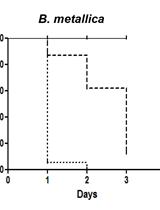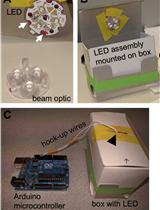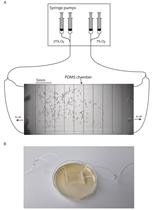- EN - English
- CN - 中文
Electroshock Induced Seizures in Adult C. elegans
成年秀丽隐杆线虫的电休克诱发性癫痫发作
发布: 2017年05月05日第7卷第9期 DOI: 10.21769/BioProtoc.2270 浏览次数: 9011
评审: Neelanjan BoseSanjib Kumar GuhaAnonymous reviewer(s)
Abstract
The nematode Caenorhabditis elegans is a useful model organism for dissecting molecular mechanisms of neurological diseases. While hermaphrodite C. elegans contains only 302 neurons, the conserved homologous neurotransmitters, simpler neuronal circuitry, and fully mapped connectome make it an appealing model system for neurological research. Here we developed an assay to induce an electroconvulsive seizure in C. elegans which can be used as a behavioral method of analyzing potential anti-epileptic therapeutics and novel genes involved in seizure susceptibility. In this assay, worms are suspended in an aqueous solution as current is passed through the liquid. At the onset of the shock, worms will briefly paralyze and twitch, and shortly after regain normal sinusoidal locomotion. The time to locomotor recovery is used as a metric of recovery from a seizure which can be reduced or extended by incorporating drugs that alter neuronal and muscular excitability.
Keywords: Epilepsy (癫痫)Background
We were interested in using the powerful genetic model, Caenorhabditis elegans, to develop an electroconvulsive seizure assay that can be easily manipulated by pharmacology. Invertebrate models have been used in seizures research for decades (Lee and Wu, 2002) however there were no protocols specifically investigating electroconvulsive seizures in C. elegans. In the past, multiple groups have developed methods of analyzing paralysis in response to chemical proconvulsants such as the GABAA receptor blockers, pentylentetrazol (PTZ) and picrotoxin (PTX), as well as an acetylcholinesterase inhibitor, aldicarb (Williams et al., 2004; Vashlishan et al., 2008). While these methods typically analyze the time to paralysis, our method quantifies the time it takes to recover from an electric shock-induced seizure (Risley et al., 2016).
Materials and Reagents
- 60 x 15 mm Petri dishes (Excel Scientific, catalog number: D-901 )
- Pipette tips (Thermo Fisher Scientific, Thermo ScientificTM, catalog number: 0094300120 )
- Vacuum filter (Corning, catalog number: 430320 )
- 2, 20 gauge insulated copper wire, cut to 8 cm segments (Del City, catalog number: 1120101 )
- Plastic tubing, cut into 9 mm segments (Emurdock, catalog number: AAQ04127 )
Note: This product has been discontinued. - 2 x Alligator clip wires (United Scientific Supplies, catalog number: WAG024-PK/6 )
- C. elegans wild type strain N2 (obtained from Caenorhabditis Genetics Center)
- LB broth powder (Fisher Scientific, catalog number: BP1426-500 )
- Sodium chloride (NaCl) (Sigma-Aldrich, catalog number: S3014 )
- Agar (Sigma-Aldrich, catalog number: A7002 )
- Peptone (Fisher Scientific, catalog number: BP1420 )
- Calcium chloride solution (CaCl2) (Sigma-Aldrich, catalog number: 21115 )
- Magnesium sulfate solution (MgSO4) (Sigma-Aldrich, catalog number: M3409 )
- Cholesterol (Sigma-Aldrich, catalog number: C8667 )
- Ethanol (Fisher Scientific, catalog number: 04-355-226 )
- Potassium phosphate dibasic (K2HPO4) (Sigma-Aldrich, catalog number: P3786 )
- Potassium phosphate monobasic (KH2PO4) (Sigma-Aldrich, catalog number: P5655 )
- Sodium phosphate dibasic (Na2HPO4) (Sigma-Aldrich, catalog number: 795410 )
- LB broth (see Recipes)
- Nematode growth medium (NGM) agar plates (see Recipes)
- KP buffer (see Recipes)
- E. coli strain OP50 (see Recipes)
- M9 solution (see Recipes)
Equipment
- 2 L flask
- Pipettes
- Stir bar
- Dissection stereo microscope (Tritech Research, model: SMT1 )
- Dissecting stereoscope (AmScope, model: SM-1TSX )
- Timer output stimulator (Grass Instruments, model: S44 )
- Stimulator (Grass Instruments, model: SD9 )
- CCD color microscope camera (Hitachi, model: KP-D20BU )
- Television monitor (RCA, model: 19LA30RQ )
- HDD and DVD recorder (Magnavox, catalog number: MDR535H/F7 )
- DVD-Recordable discs (Verbatim, catalog number: 95032 )
- Digital oscilloscope (OWON Technology, catalog number: PDS5022T )
- Ethanol lamp (Carolina, catalog number: 706604 )
- Water bath (50 °C) (Corning, model: Corning® LSETM Digital Water Bath, catalog number:6783)
- Incubators (37 °C) (Thelco, model: 4 )
- Incubator (20 °C) (Cuisinart, catalog number: CWC 1200DZ )
- Timer (VWR, catalog number: 62344-641 )
- A metric ruler (Fisher Scientific, catalog number: 09-016 )
- Infrared Temperature Gun (J-1 Trading Wholesale, Nubee, catalog number: NUB8380 )
Software
- Open source image processing program, we use VLC media player (version 2.2.4)
- SigmaPlot 11.0 (Systat Software, Inc., San Jose, CA, USA)
Procedure
文章信息
版权信息
© 2017 The Authors; exclusive licensee Bio-protocol LLC.
如何引用
Readers should cite both the Bio-protocol article and the original research article where this protocol was used:
- Risley, M. G., Kelly, S. P. and Dawson-Scully, K. (2017). Electroshock Induced Seizures in Adult C. elegans. Bio-protocol 7(9): e2270. DOI: 10.21769/BioProtoc.2270.
- Risley, M. G., Kelly, S. P., Jia, K., Grill, B. and Dawson-Scully, K. (2016). Modulating behavior in C. elegans using electroshock and antiepileptic drugs. PLoS One 11(9): e0163786.
分类
神经科学 > 行为神经科学 > 实验动物模型 > 其它
您对这篇实验方法有问题吗?
在此处发布您的问题,我们将邀请本文作者来回答。同时,我们会将您的问题发布到Bio-protocol Exchange,以便寻求社区成员的帮助。
Share
Bluesky
X
Copy link












